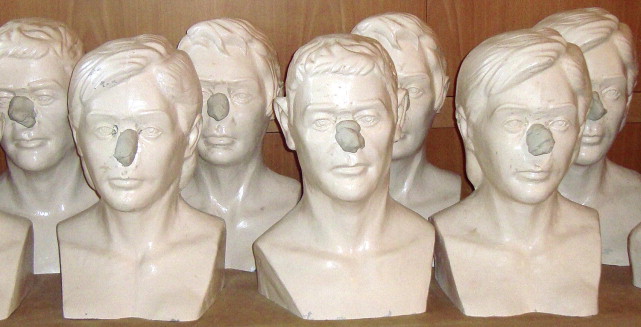This article describes the authors’ course, which takes facial plastic surgeons through specific exercises to demonstrate the esthetic impact of 3D manipulations of the nose and face. The course components are described, which include 3D assessment, exercises in manual dexterity, and improving imagination in sculpting facial and nasal features for the optimal esthetic result and match to a given facial shape. The overlap and relationship between a course in 3D sculpting in facial plastic surgery and current 3D tools for design and image analysis being used for facial plastic surgery are discussed.
The human body is a 3-dimensional (3D) object; and any changes, whether from movement during facial expression or from surgery, occur in 3 dimensions. The importance of thinking in 3D when doing facial plastic surgery extends to preoperative planning, consideration of esthetics, discussion with patients, surgical simulation, and manual dexterity in execution of the steps to attain the desired 3D goal.
Although ethnic differences exist in Turkey, we can describe the general structure of the Mediterranean nose as large and arched. The most common nasal surgery in this country currently is reduction rhinoplasty. Most patients requesting this surgery have a large nose associated with a nasolabial angle less than 90°, thick skin, and a deviated nose.
The interest in plastic surgery interventions has rapidly increased during the last 15 years and continues to rise. The interest in facial plastic surgery interventions is consistent with the general socioeconomic levels of society. The increased interest in rhinoplasty surgery began 25 years ago in the United States and was subsequently observed in European countries, including Turkey. Because of the increased interest in rhinoplasty, many otolaryngologists are keen to be taught rhinoplasty procedures and several courses and symposia continue to be organized to meet this need. These meetings are typically designed to improve theoretical knowledge in an engaging and educational manner. In accordance with the increased interest in rhinoplasty, the incidence of overcorrected noses has increased. This report is about 3D sculpting courses that the authors developed after realizing the need for education regarding planning the way to attain a suitable nose as an important element of plastic surgical interventions.
The authors have found clay to be an inexpensive, readily available medium that allows facial plastic surgeons to further explore the relationship between their 3D handwork and the 3D esthetic result. This article describes the authors’ course and study, taking facial plastic surgeons through specific exercises to demonstrate the esthetic impact of 3D manipulations of the nose and face. The authors describe the course components, which include 3D assessment, exercises in manual dexterity, and improving imagination in sculpting facial and nasal features for the optimal esthetic result and match to a given facial shape. In addition, the authors discuss the overlap and relationship between a course in 3D sculpting in facial plastic surgery and current 3D tools for design and image analysis that are used now for facial plastic surgery. This has implications for the 5 previously mentioned areas incorporating 3D thinking in facial plastic surgery: planning, esthetics, discussion, simulation, and performance.
Teaching 3D sculpting to facial plastic surgeons
Using clay, the authors produced and duplicated sample masks for these education courses ( Figs. 1 and 2 ). The objectives of the course are
- •
Internalization of nose ratios
- •
Development of eye measurements
- •
3D thinking
- •
3D planning
- •
Improving manual dexterity and eye-hand coordination
- •
Improving imagination.
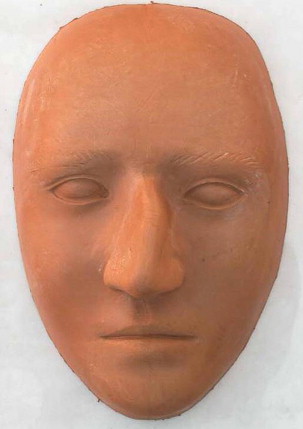
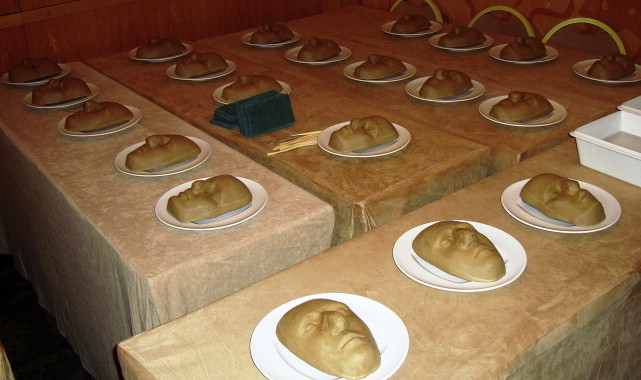
Internalization of Nose Ratios
The face is divided into 3 equal parts. These parts include 3 horizontal planes and a vertical division of the face with 5 vertical lines. To know these ratios in theory is not enough. Thus, the course starts with practice in measuring these ratios with a compass on a mud mask ( Fig. 3 ), learning to equalize these portions by making appropriate changes, and observing the results. Such practice is beneficial in the internalization of nose ratios and giving an appreciation of the relationship between measurements and the 3D facial esthetic.
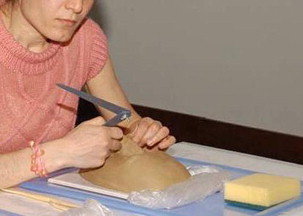
3D measurements for anthropometric and esthetic purposes have raised great interest among artists and researchers who have designed useful methods to define and measure human facial features. The assessment of facial dimensions is of prime importance in medical fields for both diagnosis and treatment planning. Given that otorhinolaryngological, maxillofacial, and plastic reconstructive surgeons often require quantitative information regarding the relationships of hard and soft tissue, image processing algorithms using 3D image acquisition tools described at the end of this article may be applied to facial images to develop and improve anthropometric applications that reduce the time required for examination and improve measurement reliability. Additionally, the detection of clinically important distances and angles and the analysis and comparison of different forms can be enabled by such applications.
Three-Dimensional Thinking and Planning
Thinking and seeing in 3D is rarely included in classical medical training. Realizing the effects of the minor modifications of the tip of the nose on the profile appearance or on a three-quarter view may be described by some as 3D planning. However, to truly be 3D planning, it should take into consideration the view of patients during daily social interactions, not only from the front or side but also from all angles by evaluating the view from all perspectives. Many people describe their profiles (side views) as improving when they lift the tip of their nose with their fingertip, a process termed unidirectional evaluation. If a surgical process to achieve this lifting effect is performed, the profile lines may be improved; but this exact profile view is rarely achieved in daily life, which highlights the necessity of 3D planning. The surgeon, and others, will view patients in 3D after surgery not from a single direction.
In the case of facial plastic surgery, it is important to perform detailed surgical planning before surgery to ensure that the optimal and appropriate surgical methods are applied. Historically, esthetic surgical practice did not include 3D planning, but current advances in 3D technology are changing that.
Development of Eye Measurements
Eye measurement is a skill that can be developed through practice. Precise eye measurements are important to ensure equalization of the 3 horizontal facial areas. During the clay study, the participants first assess sizes, shapes, and angles with their eyes, followed by measurements with a compass. The aim of this evaluation is to allow the participants to become accustomed to eye measurements, which will foster improvement in their accuracy.
As an example, we might describe the basic technique of placing a suture as beginning 2 mm outside the upper edge of the lip of the wound and exiting inside the wound 2 mm from the surface. This procedure is followed by entering 2 mm below the surface of the incision at the opposite lip of the wound and exiting 2 mm outside the upper edge of the lip of the wound. The suture is tightened by tying a knot. Good eye measurements, as well as excellent manual dexterity and hand-eye coordination, are all required to ensure that this procedure is performed correctly.
Improving Manual Dexterity
Fine-motor movements of the hands improve during the kindergarten period, and exercises are performed during preschool for this purpose. Some individuals increase their manual dexterity during their youth, whereas others do not have the opportunity to do so. Thus, if individuals who have graduated from medical school continue their otorhinolaryngology education and perform exercises that improve their manual dexterity, one can predict an improvement in the success of their operations. Exercises to both assess and improve manual dexterity include
- •
Cutting pictures from a newspaper without missing the borders: This exercise serves to identify those participants who are neater and faster. This practice can persuade participants who are unsuccessful to spend extra time practicing these exercises.
- •
A competition attempting to align 100 beads in the shortest time possible: At the end of this exercise, a bell curve is generated. Most of the group can complete this in an average or very short period of time. Some take longer to complete the exercise, and this group might be offered further exercises to improve manual dexterity.
- •
Suturing 4 sides of a 2 × 2-mm section of cartilage on gauze with 4 sutures: This exercise simulates difficulties encountered during suturing of a graft, including when cartilage graft placement is necessary during rhinoplasty. These difficulties include disruption of the graft when crossing the suture and tearing of the graft caused by excessive tightening of the suture. Those who are unsuccessful at the end of this exercise are frequently motivated to pursue additional training and to do exercises to improve their manual dexterity.
Improving the Imagination
When the clay masks are provided to participants, they are initially required to distribute the face into the appropriate proportions and design an ideal nose for these proportions. Box 1 shows the tools that are used in the course ( Fig. 4 ). The aim is then to perform changes that would not be possible to perform on patients. Most participants who become accustomed to training with clay frequently request clay masks to perform the exercise outside of the training period.
- •
Clay and water
- •
Ceramic hand tools
- •
Sponge
- •
Brush
- •
Compass

Steps of the course
Study Phases on Large-Nosed Clay Masks
- 1.
First, facial proportions are assimilated using sample clay masks derived from patients. An assessment of the horizontal and vertical components of the face is performed by measuring the face with a compass.
- 2.
The deformed nose on the mask is then optimized to the known desirable proportions of the face ( Fig. 5 ).
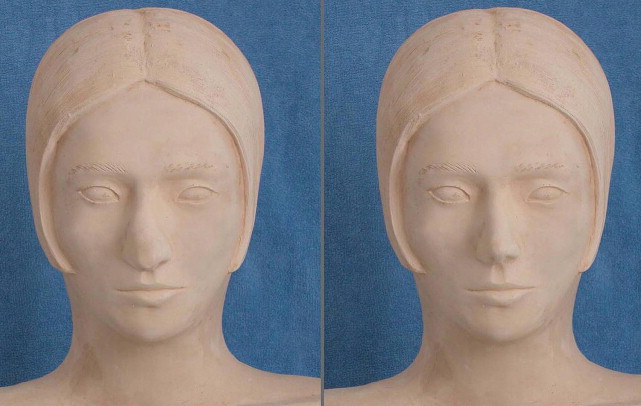
Fig. 5
The deformed clay nose is optimized to the known desirable dimensions of the face.
- 3.
Interventions that will esthetically improve the face (apart from the nose) are performed, including chin advancement and raising the eyebrows.
- 4.
The final goal is to design the ideal nose for this face ( Figs. 6 and 7 ).
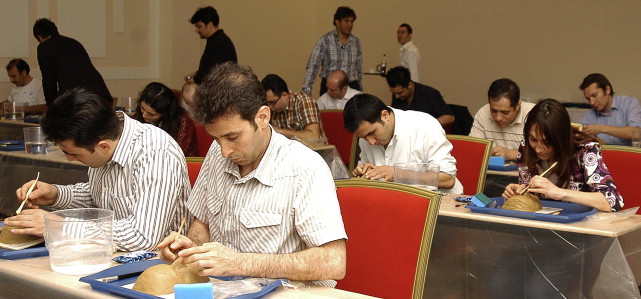
Fig. 6
The participants design an ideal nose of the appropriate proportions for their mask.
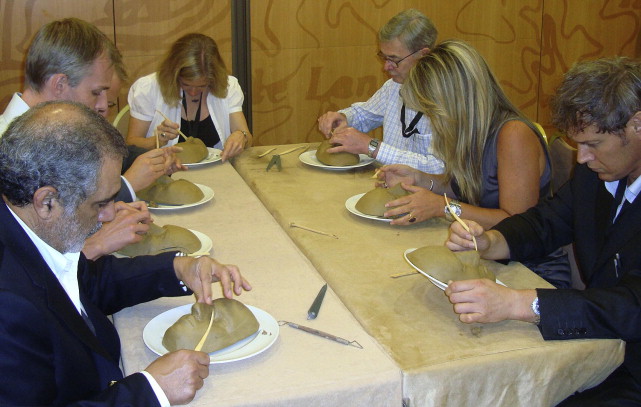
Fig. 7
The participants in phase 1 are designing the ideal nose for the face on their mask.
Once this stage is complete, the aim is to perform changes to the mask that cannot be performed on patients and to create an ideal nose. This nose may be incongruous with the facial proportions. Participants in the training can observe directly whether the designed nose fits the face.
Studies on Sculptures Without a Nose
This study is more difficult to perform and is regarded as the second phase. In phase 1, the participants begin with a nose on the clay mask that is typically deformed. In this instance, it is easy to observe and correct the defect. Adding a nose to a noseless sculpture ( Fig. 8 ) during the second phase is more difficult, but it is an important skill to master for 3D planning and training.

At this stage, the determination of the nasofrontal angle is ensured by directing the participants. The next goal is to create the dorsum and to decide the level of nasal projection. Once this is completed, the nostrils and columella are created. The basal view of the nose is frequently the most difficult section for the participants.
Steps of the course
Study Phases on Large-Nosed Clay Masks
- 1.
First, facial proportions are assimilated using sample clay masks derived from patients. An assessment of the horizontal and vertical components of the face is performed by measuring the face with a compass.
- 2.
The deformed nose on the mask is then optimized to the known desirable proportions of the face ( Fig. 5 ).

Fig. 5
The deformed clay nose is optimized to the known desirable dimensions of the face.
- 3.
Interventions that will esthetically improve the face (apart from the nose) are performed, including chin advancement and raising the eyebrows.
- 4.
The final goal is to design the ideal nose for this face ( Figs. 6 and 7 ).
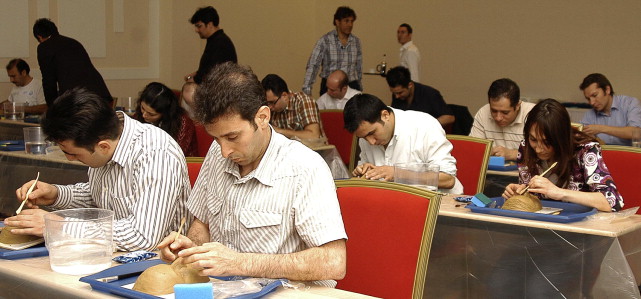
Fig. 6
The participants design an ideal nose of the appropriate proportions for their mask.

Fig. 7
The participants in phase 1 are designing the ideal nose for the face on their mask.
Once this stage is complete, the aim is to perform changes to the mask that cannot be performed on patients and to create an ideal nose. This nose may be incongruous with the facial proportions. Participants in the training can observe directly whether the designed nose fits the face.
Studies on Sculptures Without a Nose
This study is more difficult to perform and is regarded as the second phase. In phase 1, the participants begin with a nose on the clay mask that is typically deformed. In this instance, it is easy to observe and correct the defect. Adding a nose to a noseless sculpture ( Fig. 8 ) during the second phase is more difficult, but it is an important skill to master for 3D planning and training.

